.

The giant Klytios -Hecate- and Otos-Aigaion-Artemis-Group. The giants Otos and Ephialtes are children of Poseidon and Iphimedia according to Mythology killed by Apollon when they attacked the Gods in Olymp. Aigaion (or Aegeon) is one of the three Hecantocheires (Probably Briareus who according to Homer is called Aegaeon ("goatish"), a marine deity and son of Poseidon.) Hecate is the Greek goddess of the crossroads. She is most often depicted as having three heads; one of a dog, one of a snake and one of a horse. (Here with three human heads). The dog is the animal most commonly associated with Hecate, and She was sometimes addressed as the 'Black she dog'. Black dogs were once sacrificed to Hecate.http://www.hecate.org.uk/ . The dogs she preferred (and probably by the Greeks) were the Molossian dogs from a place called Molossis. Dogs in ancient and modern Greece
From the left a serpent like giant Klytios (Klytias or Clytias?) tries to throw a large stone against Hecate with the three heads. In mythology the stones could be as large as a entire island for example one such “stone” is considered to be the peninsula of Chalkidike. Athena protects herself with a shield. A serpent foot of the giant bites the shield. A dog of the Goddess bites Klytias. With a burning torch, spear and swords the Goddess with the many hands attacks Klytias. The next pair is Artemis who is fighting with her bow. An enemy, Aigaion, is on the ground in front of her and a dog bites the neck of Aigaion. Close to this pair is the Goddess Leto.
Leto throws a burning torch against the face of her opponent Tityos. Parts of the Frieze are then missing. Then Zeus and Athena are shown in the fight. Zeus is fighting against three opponents. He is ready to throw his thunderbolt against the right giant. The Goddess Athena, with a helmet on the head, shield in the hand, head of Medusa made with leather of snake on the chest, seizes by the hairs the winged giant Alkyoneous (or Alcyoneous). Gaea (or Gaia, Ge, Earth), mother of the giants, aims her hand to the Goddess while imploring to forgive her son, but the snake of Athena is poisoning the young giant. Nike comes beating her wings to celebrate the victory and to put a crown of laurel on Athena's head. At the end we see the horses of Ares, the God of war.
Ephialtes could only be killed if he was hit jointly by a mortal and a god. So Herakles and Apollo hit the right and left eye of the giant who then died from the blood from his eyes. Ephialtes is the reason we have the nightmares as his name is the Greek work for nightmare and he was send into the dreams of mortals. The question remains why we sometimes still have nightmares. Klytios was burned by Hecate with a rain of burning torches.

Details of Aigaion and the shoes of Artemis

Left Part of Artemis, Leto-Tityos, Apollo, Ephialtes, Erysichthon and Demeter (only parts or completely missing). Tityos was a giant from Euboea who tried to rape Leto and who was killed by Apollo and Artemis. Leto, the daughter of the Titans Phoebe and Coeus. Leto was the mother of Apollo and Artemis (Zeus was the father). Actually Demeter is assumed that she did not participate in the Gigantomachy because she had special affinities with Gaea as a protector of the fruits growing on earth's sacred ground.
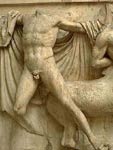
Maybe one figure inspired from a figure of the Metope 27 of the Parthenon.
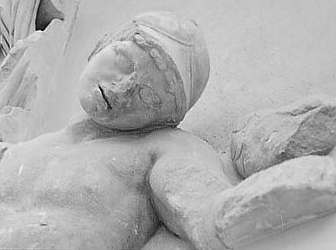
Ephialtes?

Hera with her chariot and her horses over a giant

Hercules, and Zeus against three giants including Porphyrion, on the right side the winged giant Alcyoneus. Zeus recognizable by the thunderbolt in his outstretched right hand and the aegis upon his left arm, is pitted against three antagonists. Two of the three are already disabled. The one at the left, a youthful giant of human form, has sunk to earth, pierced through the left thigh with a huge, flaming thunderbolt. The second, also youthful and human, has fallen upon his knees in front of Zeus and presses his left hand convulsively to a wound (?) in his right shoulder. The third still fights desperately. This is a bearded giant, with animal ears and with legs that pass into long snaky bodies. Around his left arm is wrapped the skin of some animal; with his right hand (now missing) he is about to hurl some missile; the left snake, whose head may be seen just above the giant's left shoulder, is contending, but in vain, with an eagle, the bird of Zeus. (Information F.B. Tarbell )

Porphyrion; Alcyoneus and Athena, Gaea and the Goddess Nike. Athena is called also Athena gigantoleteira, i.e. the slayer of the giants. Athena is the most impressive warrior. She was created from Zeus consciousness, we can say her mother and father was Zeus! Gaea somehow drills out from the Earth that she represents.

The Pergamon Nike maybe inspired by the Nike of Samothrace
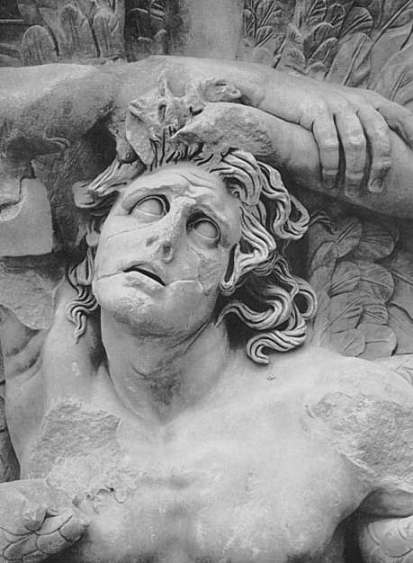
Details of Alcyoneus beaten by a snake. Alcyoneus was the most powerful giant who gained his power in contact with his mother Earth.

Horses and the head of Ares, the god of war. (Parts of the Wings of Nike on the Left Side)
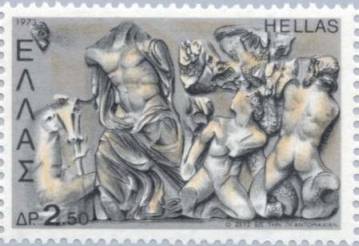
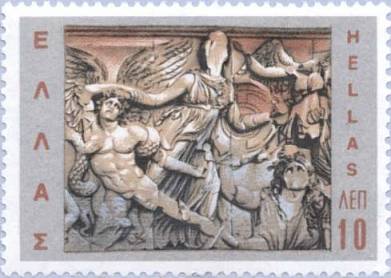
Greek Stamps: Zeus and Athena from the Zeus Altar
Zeus in Exile: Archaeological Restitution as Politics of Memory
East frieze Sculptures
From Pergamon to Sperlonga: Sculpture and Context (Hellenistic Culture and Society)- by Langford Conference of the Department of Classics 1997 Florida State (Corporate Author), Nancy Thomson De Grummond (Editor), Brunilde Sismondo Ridgway (Editor) University of California Press ( 2001) ISBN: 0520223276
| Ancient Greece
Science, Technology , Medicine , Warfare, , Biographies , Life , Cities/Places/Maps , Arts , Literature , Philosophy ,Olympics, Mythology , History , Images Medieval Greece / Byzantine Empire Science, Technology, Arts, , Warfare , Literature, Biographies, Icons, History Modern Greece Cities, Islands, Regions, Fauna/Flora ,Biographies , History , Warfare, Science/Technology, Literature, Music , Arts , Film/Actors , Sport , Fashion --- |


